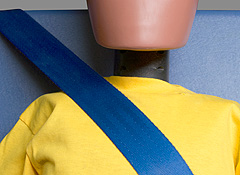Finding a booster seat that correctly fits your child is easier than ever according to a new report from the Insurance Institute for Highway Safety (IIHS). The Institute has released their annual list of the best-fitting booster seats for children age 4 to 8 years old and found that 15 of the 17 new for 2012 models earn the top rating of Best Bet by the IIHS.
Best Bets offer the best potential of correctly positioning a vehicle's seat belt on a child in a variety of vehicle types.

Overall, there are 47 Best Bets among the 91 boosters rated, along with five Good Bets. Two models from Safety 1st--the All-in-One and Alpha Omega Elite--are "Not Recommended" because they do a poor job of providing proper belt fit. Thirty-seven models are designated as a "Check Fit," which means their ability to provide a good fit will likely need to be determined on a case-by-case basis.
It's important to note that the IIHS ratings are based solely on how well each booster seat positions the lap and shoulder belt, its primary function, and are not an assessment of crash performance or vehicle fit.
Consumer Reports has a different approach to our evaluations of booster seats. In addition to a seat's ability to provide a proper belt fit in a variety of vehicles, we include both crash protection and an ease-of-use assessment in our ratings. Consequently, you may find some differences between the ratings.
A well-fitting booster should put the lap portion of the seat belt flat across a child's upper thigh and the shoulder belt at mid-shoulder. This is a check that you should make with your own child in your own car when you select a booster seat (see questions for assessing booster fit below).
There are 24 boosters that show up twice on the IIHS list, as they are dual-use seats--meaning they can be used as a highback or backless seat. Our own tests and a review of the IIHS Best Bets shows that highback models tend to offer the best potential over backless versions of providing a proper belt fit.
Boosters have improved considerably the past few years. When IIHS first started conducting these tests in 2008, there were only 10 Best Bets and have now climbed to 47 after manufacturers started utilizing the IIHS test protocols when designing and updating their seats, which is a good thing for consumers.
New for 2012 Best Bets Boosters
Diono RadianR100
Diono RadianR120
Diono RadianRXT
Evenflo Big Kid Amp High Back (backless mode)
Evenflo Secure Kid LX/DLX
Graco TurboBooster (backless mode)
Graco TurboBooster (highback mode)
Graco TurboBooster COLORZ
Graco TurboBooster Safety Surround (backless mode)
Graco TurboBooster Safety Surround (highback mode)
Harmony Cruz Youth Booster
Harmony V6 Highback Booster (backless mode)
Harmony V6 Highback Booster (highback mode)
Kiddy Cruiserfix Pro
Kiddy World Plus
The IIHS test provides an important assessment when choosing a booster seat and educates parents on how belts should fit and what to look for. The IIHS test is based on fit to a dummy that represents an average sized six-year-old child, but as we know, children and cars come in all shapes and sizes, so it's important to do your own assessment to make sure the belt properly fits your child in their booster.
When assessing booster fit, ask these key questions:
Does the booster seat position the shoulder belt across the clavicle/collar bone, approximately mid-way between the neck and shoulder?
Does the booster seat position the lap belt low and flat across the hips/top of the thighs?
Does either the booster seat or vehicle head restraint provide some support behind the child's head?
Is your child comfortable and not tempted to move the belts or themselves out of position after a period of time?
All states have laws for the use of child restraints, but some are stricter than others. Currently, most states have laws that cover children up until age seven, but many others don't require child restraint use above the age of five. Variations and confusion in booster seat state laws, seat cost and inconvenience, and child discomfort are reasons why children five- through seven-years old are not always restrained in booster seats--but they should be as they can help reduce injuries in a crash.
Consumer Reports recommends booster seats be used until the child can comfortably and safely fit the vehicle belts alone. If you're unsure if your child fits the vehicle belts without a booster, ask the same questions as above but without the use of the booster.
To provide the best protection, the National Highway Traffic Safety Administration (NHTSA) recommends using a booster seat for children until they are at least eight years old or 4'9" tall. Also, all children under age 13 should ride in the rear seat.
For more information on how to choose the right infant, convertible, or booster seats, see our latest Ratings and buying advice. Also, check out our video on installing booster seats. For more on driving with kids, see our Kids and Car safety special section.
—Liza Barth





